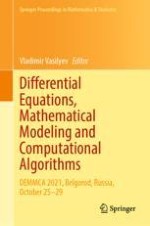This book contains reports made at the International Conference on Differential Equations, Mathematical Modeling and Computational Algorithms, held in Belgorod, Russia, in October 2021 and is devoted to various aspects of the theory of differential equations and their applications in various branches of science. Theoretical papers devoted to the qualitative analysis of emerging mathematical objects, theorems of the existence and uniqueness of solutions to the boundary value problems under study are presented, and numerical algorithms for their solution are described. Some issues of mathematical modeling are also covered; in particular, in problems of economics, computational aspects of the theory of differential equations and boundary value problems are studied. The articles are written by well-known experts and are interesting and useful to a wide audience: mathematicians, representatives of applied sciences and students and postgraduates of universities engaged in applied mathematics.
